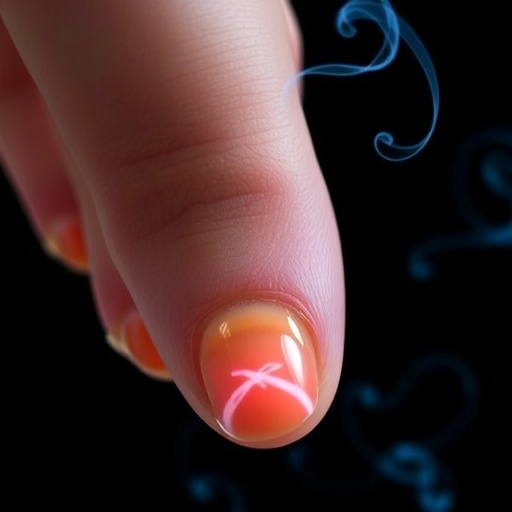Hydrogen Sulphide Emerges as a Promising Rapid Treatment for Resistant Nail Infections
Persistent nail infections have long plagued millions worldwide, especially affecting older populations and those with underlying health conditions. These infections, primarily caused by fungi and occasionally bacteria, notoriously resist standard treatments, leaving patients frustrated with lengthy courses and frequent relapses. However, groundbreaking research from the University of Bath and King’s College London now highlights hydrogen sulphide—a pungent volcanic gas—as a novel and potent weapon in the fight against these stubborn infections.
Nail infections, medically known as onychomycosis, afflict between 4 and 10% of the global population. The incidence sharply rises with age, impacting nearly 50% of individuals over seventy. This demographic faces not only cosmetic issues but also serious complications. For vulnerable groups such as diabetics and the elderly, untreated infections can culminate in painful inflammation, secondary bacterial infections, and reduced quality of life. Yet, despite their prevalence and impact, effective treatment options remain limited and ineffective for many.
Current therapeutic strategies hinge on either oral antifungals or topical applications directly on the nail. Oral treatments, while generally effective within a period of two to four months, pose systemic risks including liver toxicity and drug interactions—concerns that limit their use, particularly in patients with chronic health issues. Topical treatments offer a safer alternative but suffer from poor penetration abilities; nails act as robust barriers, impeding drug delivery to the embedded fungi. Consequently, topical agents may require years of consistent application, only for the infection to resurface post-treatment.
The core challenge lies in surmounting the nail plate’s dense keratin composition, which significantly hampers drug diffusion. Most antifungal molecules deployed topically fail to reach therapeutic concentrations at the infection site deep within the nail bed, restricting their efficacy. These intrinsic limitations underscore the urgent need for innovative treatments combining safety, efficiency, and superior permeation characteristics.
Amidst this therapeutic void, the research consortium from Bath and King’s has unveiled hydrogen sulphide (H₂S) as a potent antimicrobial candidate with an exceptional ability to penetrate nail tissue. Previously recognized as a toxic gaseous molecule with a characteristic rotten-egg odor, H₂S in minute controlled amounts exhibits fascinating biological activity. By utilizing a chemical precursor that releases H₂S gradually, the researchers ensured the gas could be delivered to the infection locus in a targeted, controlled fashion.
In vitro experiments revealed H₂S’s capability to inhibit and kill a broad spectrum of nail pathogens, including strains resistant to conventional antifungal drugs. Mechanistically, hydrogen sulphide disrupts microbial bioenergetics by interfering with cellular respiration pathways—specifically targeting energy production within fungal cells—leading to irreversible damage and cell death. This novel mode of action circumvents common resistance mechanisms that thwart existing therapies.
The superior penetration of H₂S through the nail matrix distinguishes it from current topical agents. Unlike larger antifungal molecules, the small gaseous nature of hydrogen sulphide facilitates swift diffusion across the tough keratin barrier, allowing rapid access to infection sites hidden deep beneath the nail surface. This physical advantage coupled with its unique biochemical attack on pathogens crafts a compelling therapeutic prospect.
While hydrogen sulphide’s reputation for pungency and toxicity might raise concerns, the research team emphasizes that therapeutic formulations will employ concentrations far below harmful thresholds, minimizing the risk of side effects and unpleasant odors. Advances in formulation chemistry will enable the masking or neutralization of odor without compromising antimicrobial potency.
Although the presented findings are currently confined to laboratory-based studies on cultured cell models, the promising results set a strong foundation for forthcoming clinical development. The research collective envisions translating these breakthroughs into a commercially viable topical treatment, potentially available to patients within a five-year timeframe.
Such a therapy would revolutionize the management of nail infections by offering a rapid, effective, and safer alternative to systemic drugs or prolonged topical regimens. The capacity to eradicate drug-resistant fungal strains and penetrate the nail more efficiently could significantly reduce treatment duration and relapse rates, greatly enhancing patient outcomes.
Professor Stuart Jones, leading pharmaceutical research at King’s College London, lauded the discovery as a major leap forward, optimistic about the product’s potential to transform clinical practice. This development aligns with broader efforts to harness gaseous molecules’ therapeutic attributes, marking a promising frontier in antimicrobial innovation.
As antimicrobial resistance surges globally, and conventional antifungals falter, hydrogen sulphide’s unique mechanism and delivery profile may represent a paradigm shift. This research not only opens new avenues for onychomycosis treatment but also ignites interest in the broader application of gaseous therapeutics in infectious diseases.
Given the significant burden of nail infections, their impact on public health, and the limitations of current treatments, hydrogen sulphide’s emergence as a potent nail pathogen deterrent is both timely and essential. Future clinical trials and formulation optimization will be critical to realizing its full therapeutic potential, possibly sparking a new chapter in dermatological infection management.
Subject of Research: Cells
Article Title: Antimicrobial effects and mechanisms of hydrogen sulphide against nail pathogens
News Publication Date: 31-Oct-2025
Web References:
https://www.nature.com/articles/s41598-025-22062-7
http://dx.doi.org/10.1038/s41598-025-22062-7
Keywords:
Fungal infections, Drug delivery, Medications, Pharmaceuticals, Microbiology, Human health, Health and medicine




